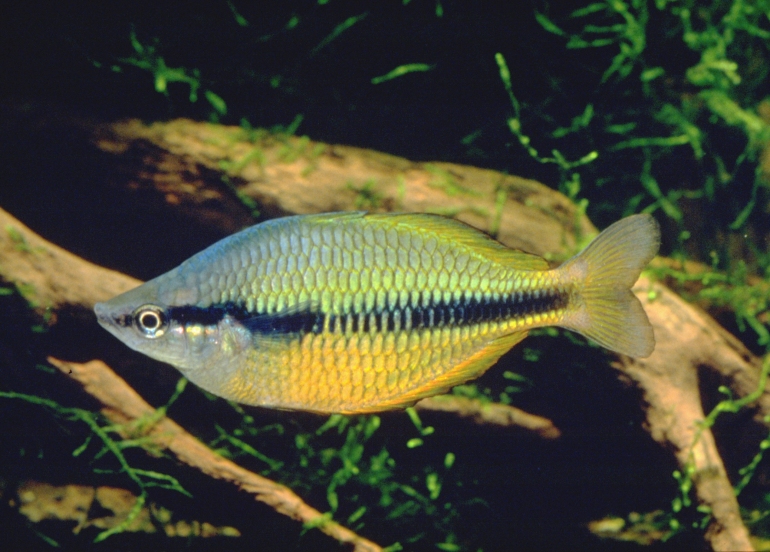|
 |
Melanotaenia herbertaxelrodi - photo© Neil Armstrong |
Allen, 1981
Lake Tebera Rainbowfish
Species Summary
Melanotaenia herbertaxelrodi belongs to a group of rainbowfish species, which inhabits the Highland drainage systems of the Kikori and Purari Rivers. This group contains two other species, M. monticola and M. lacustris. Gerald Allen believes that the three species are probably derivatives of the same ancestral stock of M. goldiei, which ranges widely in the lowland and foothill areas of southern New Guinea. Melanotaenia herbertaxelrodi is most closely related to M. monticola from the upper Purari System near Mendi, about 200 km upstream from the Lake Tebera Basin. Males are mainly bright yellow (sometimes greenish) with a blue-black, mid-lateral line. The dorsal, anal, and caudal fins can be red or yellow. During spawning the male has an intense blue or white stripe from the first dorsal fin extending down over the nape to the tip of the snout, while the whole head can become almost black. The rest of the body is bright yellow with reddish fins.
Melanotaenia herbertaxelrodi may reach a maximum size of 12 cm, but usually less than 10 cm. Males are typically deeper bodied than females and develop a high forehead and an angulated breast profile with increased growth. The body begins to deepen in males after a length of 45-50 mm SL is attained or at about the onset of sexual maturity. In addition, the middle portion of the first dorsal fin is much longer in males and the posterior outline of the second dorsal fin is more pointed than in females, although this difference is not nearly as apparent as in many other members of the Melanotaenia genus.
.NA.jpg) |
Melanotaenia herbertaxelrodi [wild-caught] - photo© Neil Armstrong |
Distribution & Habitat
Melanotaenia herbertaxelrodi was collected by Gerald Allen and Brian Parkinson in September 1980 from a small clear water stream about 4 km east of Lake Tebera. Lake Tebera, about 410 kilometres northwest of Port Moresby, is situated in the rugged Central Highlands of Papua New Guinea and is part of the Purari River System. Lake Tebera is composed of numerous interconnecting ponds, swamps and springs that occupy a basin that is about 10 kilometres long and 2 kilometres wide. Melanotaenia herbertaxelrodi are usually found around the shoreline margin in tall grasses or sub-surface vegetation.
The search for Melanotaenia herbertaxelrodi came about after Patricia Kailola, then curator of the Kanudi Fisheries Research Lab in Port Moresby, sent a photo to Gerald Allen of an unusual rainbowfish collected by Grant West at Lake Tebera. Although the specimens in the photo were dead and faded, Gerald Allen recognised that it was clearly a new species. After collecting specimens for proper identification, he later named them Melanotaenia herbertaxelrodi in honour of Herbert R. Axelrod who funded the collecting expedition.
Remarks
The first live specimens to enter the aquarium hobby were collected by Gerald Allen in 1980 and were brought back into Australia where they were later bred and distributed in the hobby.
Literature
Allen G.R. (1981) Central highland rainbows from Papua New Guinea, with descriptions of two new species (Melanotaeniidae). Tropical Fish Hobbyist 29 (5): 20-33, 68-81.
Allen G.R. (1991) Field guide to the freshwater fishes of New Guinea. Christensen Research Institute, Madang, Papua New Guinea.
Kailola P.J. (1987) The fishes of Papua New Guinea. A revised and annotated checklist. Vol. 1. Myxinidae to Synbranchidae. Research Bulletin No. 41. Department of Fisheries and Marine Resources, Port Moresby, Papua New Guinea.
Adrian R. Tappin
Updated December, 2008



|

